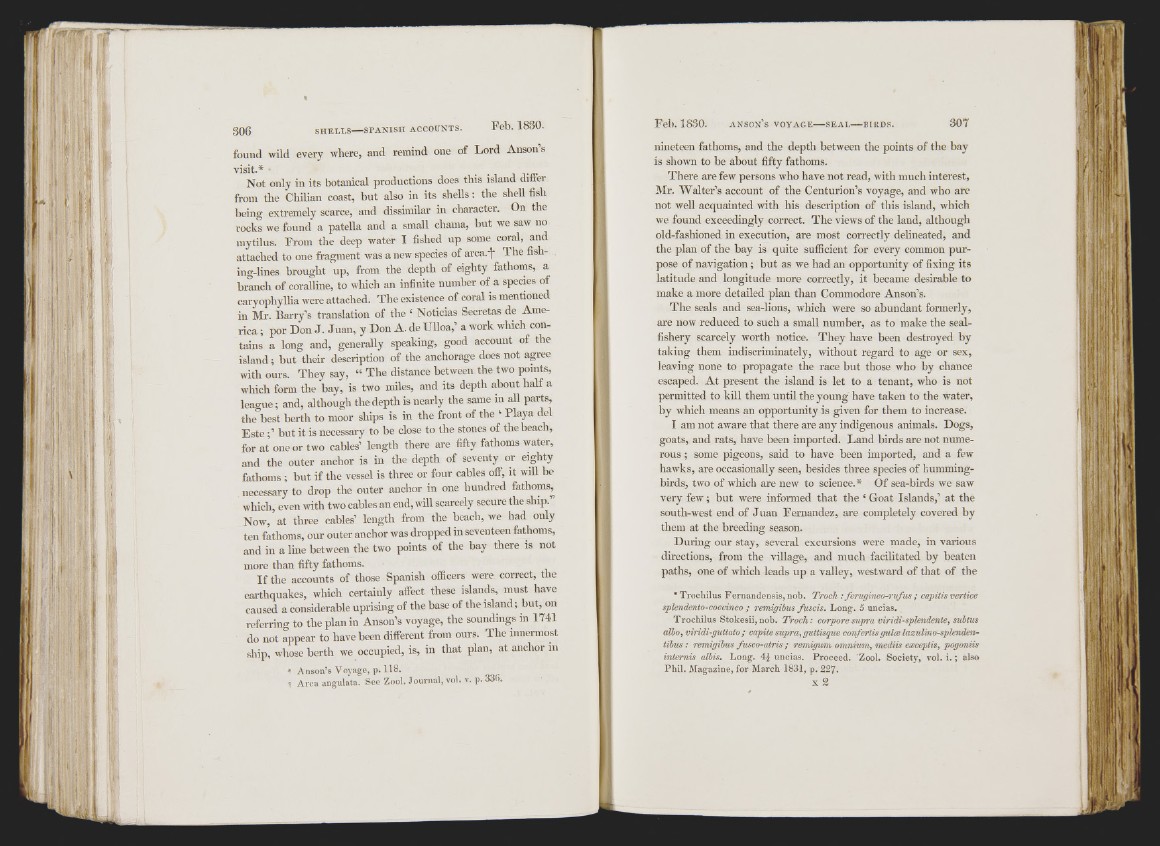
i ' i'
Sí
found wild every where, and remind one of Lord Anson s
visit.* • . . -n?
Not only in its botanical productions does this island diffei
from the Chilian coast, hut also in its shells; the shell fish
being extremely scarce, and dissimilar in character. On the
rocks we found a patella and a small chama, but we saw no
mytilus. From the deep water I fished up some coral, and
attached to one fragment was a new species of arca.f The fishing
lines brought up, from the depth of eighty fathoms, a
branch of coralline, to which an infinite number of a specms of
caryophyllia were attached. The existence of coral is mentioned
in Mr. Barry’s translation of the ‘ Noticias Secretas de America
; por Don J. Juan, y Don A. de Ulloa,’ a work which contains
a long and, generally speaking, good account of the
island; but their description of the anchorage does not ap-ee
with ours. They say, “ The distance between the two points,
which form the bay, is two miles, and its depth about half a
league; and, although the depth is nearly the same in all parts,
the best berth to moor ships is in the front of the ‘ Playa del
F s te ;’ but it is necessary to be close to the stones of the beach,
for at one or two cables’ length there are fifty fathoms water,
and the outer anchor is in the depth of seventy or eighty
fathoms ; hut if the vessel is three or four cables off, it will be
necessary to drop the outer anchor in one hundred fathoms,
which, even with two cables an end, will scarcely secure the ship.’’
Now, at three cables’ length from the beach, we had only
ten fathoms, our outer anchor was dropped in seventeen fathoms,
and in a line between the two points of the bay there is not
more than fifty fathoms.
I f the accounts of those Spanish officers were correct, the
earthquakes, which certainly affect these islands, must have
caused a considerable uprising of the base of the island; but, on
referring to the plan in Anson’s voyage, the soundings in 1741
do not appear to have been difterent from ours. The iimermost
ship, whose berth we occupied, is, in that plan, at anchor in
• A nson’s Voyage, p. 118.
I Area angulata. Sec Zool. Journal, vol. v. p. 33(1.
nineteen fathoms, and the depth between the points of the bay
is shown to be about fifty fathoms.
There are few persons who have not read, with much interest,
Mr. AValter’s account of the Centurion’s voyage, and who are
not well acquainted with his description of this island, which
we found exceedingly correct. The views of the land, although
old-fashioned in execution, are most correctly delineated, and
the plan of the bay is quite sufficient for every common purpose
of navigation; but as we had an opportunity of fixing its
latitude and longitude more correctly, it became desirable to
make a more detailed plan than Commodore Anson’s.
The seals and sea-lions, which were so abundant formerly,
are now reduced to such a small number, as to make the seal-
fishery scarcely worth notice. They have been destroyed hy
taking them indiscriminately, without regard to age or sex,
leaving none to propagate the race but those who hy chance
escaped. At present the island is let to a tenant, who is not
permitted to kill them until the young have taken to the water,
by which means an opportunity is given for them to increase.
I am not aware that there ai-e any indigenous animals. Dogs,
goats, and rats, have been imported. Land birds are not numerous
; some pigeons, said to have been imported, and a few
hawks, are occasionally seen, besides three species of hummingbirds,
two of which are new to science.* Of sea-birds we saw
very few; but were informed that the ‘ Goat Islands,’ at the
south-west end of Juan Fernandez, are completely covered by
them at the breeding season.
During our stay, several excursions were made, in various
directions, from the village, and much facilitated by beaten
paths, one of which leads up a valley, westward of that of the
* Trochilus Fernandensis, nob. Troch : ferugineo-riifiis ; capitis vertice
splendento-coccineo ; remigibus fu s cis. Long. 5 uncías.
TI'ochilus Stokesii, nob. T ro ch : corpore supra viridi-splendente, suhtus
albo, viridi-guttato; capite supra,guttisque confertisgtilie lazulino-splendeTS-
tibiis; remigibus fusco-atris ; remigum omnium, mediis excepiis, pogoniis
inteniis albis. Long. 4^ uncías. Proceed. Zool. Society, vol. i . ; also
P h il. Magazine, for March 1831, p. 227.
X 2